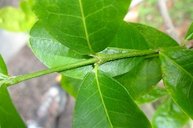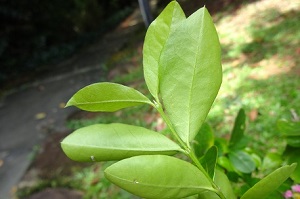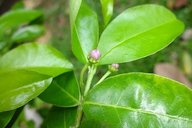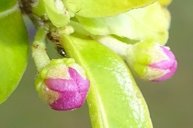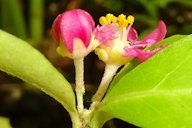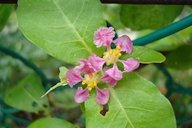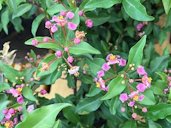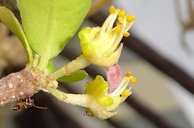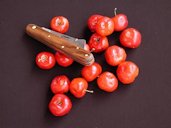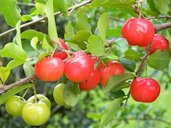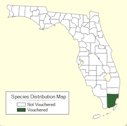| Barbados Cherry - Malpighia emarginata | |||||||||||||||||||||||||||||
|---|---|---|---|---|---|---|---|---|---|---|---|---|---|---|---|---|---|---|---|---|---|---|---|---|---|---|---|---|---|
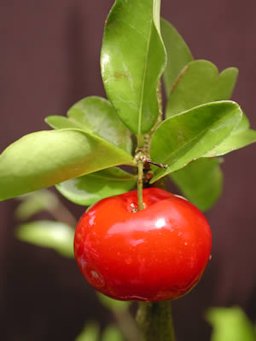 Fig. 1 Malpighia emarginata. M. punicifolia 'Florida Sweet' 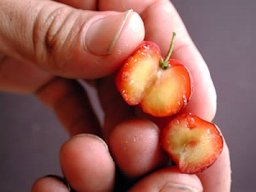 Fig. 2  Showing the flesh  Fig. 3  Leaves 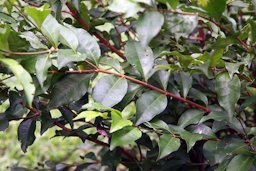 Fig. 4  M. glabra L., Else Kientzler Botanical Garden, Sarchi Norte, Costa Rica 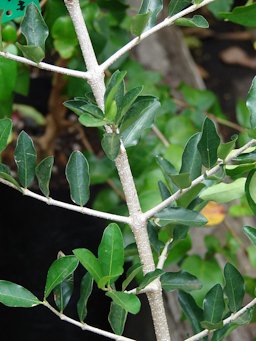 Fig. 5  M. emarginata (leaves and stems), Maui, Kula Ace Hardware and Nursery 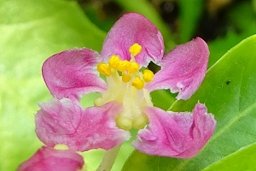 Fig. 9  Flower close up 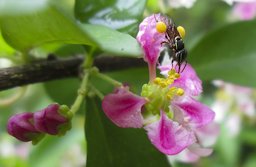 Fig. 10  Abelha pequena com as patas traseiras com pólen 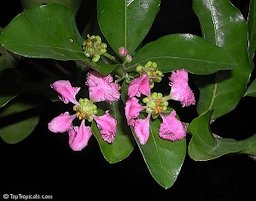 Fig. 11  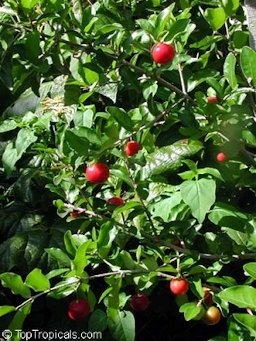 Fig. 18  Mature fruit and leaves  Fig. 19  Fruiting habit of the acerola  Fig. 20  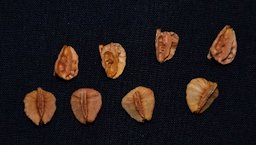 Fig. 25   Fig. 26  Bowl of Barbados cherries 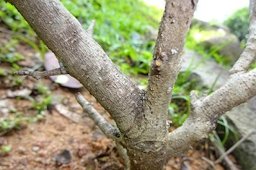 Fig. 27  Trunk habit 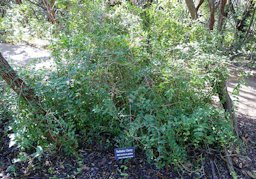 Fig. 28  Botanical specimen in the Zilker Botanical Garden - Austin, Texas, USA 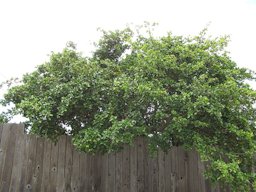 Fig. 29  M. emarginata (Acerola, Barbados cherry), habit at Waikapu, Maui, Hawai'i  Fig. 30  Cambridge University Botanic Garden 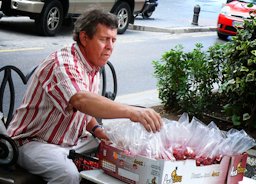 Fig. 32   Fig. 33  Acerolas, Sao Paulo, Brazil |
Scientific
name Malpighia emarginata DC. (also known as M. glabra L. and M. punicifolia) Common names English: Barbados-cherry, acerola, West Indian cherry, native cherry, garden cherry, French cherry; Spanish: acerola, cereza, cereza colorada, cereza de la sabana, grosella; French: acerolier, cerise de Cayenne, cerisier, cerisier de Barbade, cerisier des Antilles , cerise de St. Domingue; German: Barbadoskirsche, Westindische Kirsche; Portuguese: cerejeira-das-Antilhas, cereja do Pará, cerejeira, gineira da Jamaica; Swedish: barbadoskörsbär; Venezuela: semeruco, or cemeruco; Netherlands Antilles: shimarucu; Philippines: malpi (an abbreviation of the generic name) 2,13 Synonyms M. berteroana Spreng.; M. lanceolata Griseb.; M. punicifolia var. lancifolia Nied.; M. punicifolia var. obovata Nied.; M. punicifolia var. vulgaris Nied.; M. retusa Benth.; M. umbellata Rose; M. urens var. lanceolata (Griseb.) Griseb. 6,12 Relatives Peanut butter (Bunchosia argentea), nance (Byrsonima crassifolia) Family Malpighiaceae (acerola family) Origin Native to the Lesser Antilles from St. Croix to Trinidad, also Curacao and Margarita and neighboring northern South America as far south as Brazil 2 USDA hardiness zones 8-11 Uses Fruit; specimen; container or above-ground planter; border; hedge; near a deck or patio; screen 1 Height 10-12 ft (3-3,7 m) Spread 10-15 ft (3-4.6 m) Crown Rounded canopy of fairly delicate foliage 1 Plant habit Upright or sprawling depending on the cultivar 7 Growth rate Relatively fast growing, often 3-4 ft a year 4 Trunk/bark/branches Minutely hairy branches with lenticels; erect to spreading; bark slightly rough, grey-brown; short trunk to 4 in. (10 cm) in diameter 2,10 Leaves Evergreen; simple, opposite, lanceolate; 2-4 in. (5.1-10.2 cm) 1 Flowers Hermaphroditic; small; pink; open 4-5 a.m.; Apr.-Oct. Fruit Drupe; round; bright red, fleshy; tart tasting; persists on the plant; 0.5-1 in. (1.3-2.5 cm) 1 Season May-Nov.; sparsely most of the year USDA Nutrient Content pdf Light requirement Full sun Soil tolerances Slightly alkaline; clay; sand; acidic; loam 1 pH preference 5.5-6.5 Drought tolerance High Aerosol salt tolerance Not salt-tolerant Soil salt tolerance Not salt-tolerant Cold tolerance Mature trees can survive brief exposure to 28 °F (-2.22 °C); young plants are killed below 30 °F (-1.11°C ) Plant spacing 10-15 ft (3-4.6 m); as a hedge, 6-8 ft (1.8-2.4 m) 17 Roots Shallow root system; benefits from heavy mulching Invasive potential * Not known to be invasive Pest resistance Pests include nematodes, whiteflies, scale, and plant bugs, which will attack and deform the fruit 1 Known hazard People who pick Barbados cherries without gloves and long sleeves may suffer skin irritation from contact with the minute stinging hairs on the leaves and petioles 2 Reading Material Barbados Cherry - A Mother's Day Gift That Lasts, Okeechobee News, University of Florida Malpighia glabra Barbados Cherry, University of Florida pdf Barbados Cherry, Fruits of Warm Climates Barbados Cherry, University of Florida, Palm Beach County Malpighia glabra, Agroforestree Database Taxonomy In the past, according to Carrington and King (2002), the plant was known by the synonyms Malpighia glabra L. and Malpighia punicifolia L., but recent taxonomic work has resulted in the acceptance of Malpighia emarginata DC. as its scientific name. 10 The genus Malpighia contains about 40 species and is a member of the Malpighiaceae family with about 1300 species. The two most common binomials for acerola are M. emarginata (7 synonyms) and M. glabra (14) with some common to both as in the past they have been difficult to robustly classify using morphological features. However modern molecular techniques reveal small differences in genetic markers between them. 11 Origin The Barbados cherry is native to the Lesser Antilles from St. Croix to Trinidad, also Curacao and Margarita and neighboring northern South America as far south as Brazil. It has become naturalized in Cuba, Jamaica and Puerto Rico after cultivation, and is commonly grown in dooryards in the Bahamas and Bermuda, and to some extent in Central and South America. 2 It is now cultivated throughout the tropics and in subtropical areas such as Florida, Australia and Israel. 10 Description The Barbados cherry is a minor fruiting species that produces a dependable crop in South Florida. The tree is compact, attractive and requires little care. It is well adapted to Florida growing conditions and fruits abundantly over many months. As a dooryard tree it has many advantages. Better selections are mild and faintly sweet. However, the grumichama and cherry of the Rio Grande both produce a superior cherrylike fruit. 7 Leaves Its evergreen leaves are elliptic, oblong, obovate, or narrowly oblanceolate, somewhat wavy, 3/4 to 2 3/4 in (2-7 cm) long, 3/8 to 1 5/8 in (9.5-40 mm) wide, obtuse or rounded at the apex, acute or cuneate at the base; bearing white, silky, irritating hairs when very young; hairless, dark green, and glossy when mature. 2
Fig. 7. M. glabra, Tiếng Việt: Sơ ri, leaf habit Flowers The flowers, in sessile or short-peduncled cymes, have 5 pink or lavender, spoon-shaped, fringed petals. 2 Anthesis occurs very early in the mornings and flowers only last a day. 11 Flowering and concomitant fruiting can occur throughout the year, but typically occur in cycles associated with rainfall. Usually, they take place in 25-day cycles, up to eight times per year. 10
Fruit The fruits, borne singly or in 2's or 3's in the leaf axils, are oblate to round, cherry-like but more or less obviously 3-lobed; 1/2 to 1 in (1.25-2.5 cm) wide; bright-red, with thin, glossy skin and orange-colored, very juicy, acid to subacid, pulp. The 3 small, rounded seeds each have 2 large and 1 small fluted wings, thus forming what are generally conceived to be 3 triangular, yellowish, leathery-coated, corrugated inedible "stones". 2 Most varieties of acerola contain at least the minimum adult daily requirement of vitamin C, so if you don't like taking vitamin tablets, simply eat a Barbados cherry every day to get your vitamin C. 4 Vitamin C content ranges from 1000 to 2000 mg per 100 gm in the edible portion of fully ripe fruit and may be as high as 4500 mg per 100 gm in partially ripe fruit. 17
Varieties Barbados cherry seedlings are quite variable and fruit quality is usually not as good as desired. A number of improved selections have been developed. Homeowners should look for improved clones such as 'Florida Sweet' (introduced in 1956) and 'B-17'. The latter is an acid selection with much larger fruit. Season The acerola tree bears fruit in the first year of development, and from thereon may present four to eight production peaks per year. 14 In Florida, the Bahamas, Puerto Rico and Hawaii the fruiting season varies with the weather. There may be a spring crop ripening in May and then successive small crops off and on until December, but sometimes, if spring rains are lacking, there may be no fruits at all until December and then a heavy crop. 2 Harvesting For home use, as dessert, the fruits are picked when fully ripe. For processing or preserving, they can be harvested when slightly immature, when they are turning from yellow to red. As there is continuous fruiting over long periods, picking is done every day, every other day, or every 3 days to avoid loss by falling. 2 After maturation, acerola ripening and senescence are fast which makes it difficult to handle and storage after harvest. 14 Vacuum dehydrated concentrate powder keeps for over 12 months in cans under refrigeration if a desiccant bag is added. 16 Pollination In Florida, bees visit Barbados cherry flowers in great numbers and are the principal pollinators. 2 Propagation Barbados cherry is usually propagated by air layering (marcottage) or by hardwood cuttings. Air layering is best done during spring and summer while the plants are growing and requires 6 to 8 weeks for rooting. Leafy hardwood cuttings from healthy plants root within 2 months. Indolebutyric acid will help to induce rooting. It can also be propagated by side veneer or cleft grafts on young seedlings or on trees which produce inferior fruit. 5 Planting Acerola grows well in a wide variety of soils, provided they are well drained and are not infested with nematodes. Choose sites with good water drainage, as this plant does not like wet feet. Salt tolerance for this plant is moderate - it will not do well if planted in ocean-front breezes or irrigated with brackish water. New plants are best set out in spring, just before the rainy season. Specimen trees in home plantings should be allowed at least 15 feet of growing room. 3 Fertilizing Fertilize trees with a general-purpose fertilizer every three to four months to help promote good growth and fruit production. Most Barbados cherries can take small amounts of salt spray, but are not considered highly salt-tolerant for oceanfront plantings. During periods of drought, Barbados cherries will benefit from heavy mulching, since they have very shallow roots which easily dry out. Weekly irrigations are suggested during the spring dry season to help promote heavier fruiting. 4 Pruning The plant will tolerate heavy pruning, but requires time for recovery. In more tropical areas, plants do not seem overly affected by pruning. Can be kept as a small bush (e.g. 5 ft) and will produce well. 8 Pests The major pest in Florida is the Caribbean fruit fly, Anastrepha suspensa, which seems to attack all but very sour fruits and the larvae are commonly found inside. 2 A serious pest of the Barbados cherry is the root-knot nematode which weakens the plant, causing it to drop leaves and display symptoms of malnutrition. Severe infestations inhibit growth and fruit production. This nematode is a more serious problem in sandy soils than in the alkaline, rockland soils. It is not a problem in marl or clay soils. Preventive measures include use of sterilized soil in propagation, fumigation of the planting site and heavy mulching around the tree. 5 Frequently, the fruit is attacked by plant bugs which sting the fruit, giving it a dimpled appearance. This may result in off flavors and reduced fruit size. There is no practical control for this pest. Other insects which attack the tree include various scale insects, whiteflies, aphids and caterpillars. 5 Diseases Few diseases have been reported. However, in Florida, there are cases of anthracnose caused by Colletotrichum gloeosporioides, and leafspotting by the fungus, Cercospora bunchosiae, is a serious malady in Florida, Puerto Rico and Hawaii. 2 Cercospora leaf spot is the only disease problem on Barbados cherry of much concern in Florida where its occurrence is associated with high humidity. The spots are roughly circular, slightly sunken, dark brown lesions with gray centers and are surrounded by a yellow halo. The lesions occur on both leaf surfaces and are typically larger on young leaves than on mature ones. 5 Food Uses Barbados cherries are eaten out-of-hand, mainly by children. For dessert use, they are delicious merely stewed with whatever amount of sugar is desired to modify the acidity of the particular type available. The fresh juice will prevent darkening of bananas sliced for fruit cups or salads. It can be used for gelatin desserts, punch or sherbet, and has been added as an ascorbic acid supplement to other fruit juices. The fruits may be made into sirup or, with added pectin, excellent jelly, jam, and other preserves. 2 Wine made from Barbados cherries in Hawaii was found to retain 60% of the ascorbic acid. 2 Acerola was used as one of a combination of four flavours: Açai (Euterpe oleracea), pomegranate and blue- berry for vodka. Acerola flavour is also used in Tic Tac (mint sweet) dragées (sugar-coated confection). 16 Acerolas contain plenty of Vitamin A, some B and plenty of minerals. Most fruits and vegetables lose their Vitamin C when cooked, but research reveals that this does not happen with Acerolas, so you can make jellies and cordials for the winter. Frozen Acerola Juice was found to retain 85% of its original Vitamin C after eight months of freezing. 9 Medicinal Properties ** The fruits are considered beneficial to patients with liver ailments, diarrhea and dysentery, as well as those with coughs or colds. The juice may be gargled to relieve sore throat. 2 The fruit is widely used in the health industry as a natural source of vitamin C. 14 Though acerola is widely accepted as having a diverse range of health, pharmacological and nutritional benefi ts both in its fresh and processed forms, not enough studies have yet focused on improving fundamental knowledge for rational cultivar selection, improving fruit yield, size and skin thickness and reduction in or elimination of seeds via biotechnology. Especially as marketing is strongly based on its high vitamin C content and abundance of carotenoids, there needs to be further research into the stability of these antioxidants in fresh-cut fruit, in bottled juice and even in nutraceuticals and products where acerola juice is combined with other fruit juices and manufactured into energy beverages, sport drinks and other functional food products. 18 Other Uses The wood is surprisingly hard and heavy. Trials have demonstrated that it refuses to ignite even when treated with flammable fluid unless perfectly dry. 2 General The multitrunks rise sinuously up through the crown creating a sculptured specimen well-suited for placing near a patio, deck or entry way to attract attention. It looks great lighted at night from below the tree. 1 Malpighia is a popular bonsai subject (especially in Taiwan) because of its small leaf and fruit, and fine ramification. During World War II, the USDA distributed seedling trees for growing in Victory Gardens and in school yards to increase the vitamin intake of children. 3
Fig. 31. Barbados cherry distribution map, wild population Further Reading Acerola, Archives of the Rare Fruit Council of Australia Acerola Cherry, Sub-Tropical Fruit Club of Qld Acerola, The West Indian Cherry, Common trees of Puerto Rico and the Virgin Islands Malpighia glabra, PROSEA Foundation Older Material The Barbados or West Indian cherry, 1958, Florida Agricultural Experimental Station Bulletin pdf Acerola, Nutritive Value and Home Use, 1961, Hawai'i Agricultural Experiment Station, University of Hawai'i pdf Barbados Cherry, California Rare Fruit Growers List of Growers and Vendors |
||||||||||||||||||||||||||||
| Bibliography 1 Gilman, Edward F. "Malpighia glabra Barbados Cherry." Environmental Horticulture Dept., UF/IFAS Extension, FPS-390, Original Pub. Oct. 1999, Revised Oct. 2023, AskIFAS, edis.ifas.ufl.edu/fp390. Accessed 20 Jan. 2015, 31 Dec. 2023. 2 Fruits of Warm Climates. Julia F. Morton, Miami, 1987. 3 Culbert, Daniel F. "Barbados Cherry - A Mother's Gift That Lasts." Feature Article for Okeechobee News, 10 May 1998, UF/IFAS, Okeechobee County Extension Service, AskIFAS, okeechobee.ifas.ufl.edu. 4 Joyner, Gene. "Barbados Cherry." UF/IFAS, Palm Beach County Extension Service, AskIFAS, edis.ifas.ufl.edu. Accessed 21 Jan. 2015. 5 Phillips, R. L. "Barbados Cherry." Environmental Horticulture Dept., UF/IFAS Extension, FC28, Pub. Apr. 1994, Reviewed Nov. 2005, Archived, AskIFAS, edis.ifas.ufl.edu. Accessed 21 Jan. 2015. 6 "Malpighia emarginata DC. synonyms." World Flora Online, www.worldfloraonline.org/taxon/wfo-0000449743. Accessed 17 Sept. 2021. 7 Boning, Charles R. Florida's Best Fruiting Plants- Native and Exotic Trees, Shrubs, and Vines. Sarasota, Pineapple Press, 2006. 8 "Barbados Cherry." California Rare Fruit Growers, 1969-1989, crfg.org. Accessed 21 Jan. 2015. 9 Spear, Marjorie. "Acerola." Archives of the Rare Fruit Council of Australia, July 1987, rfcarchives.org.au. Accessed 26 Mar. 2017. 10 Yahia, Elhadi M. "Acerola (Malpighia emarginata DC.)." Postharvest Biology and Technology of Tropical and Subtropical Fruits: Volume 2: Acai to Citrus, 2011, ZLibrary, b-ok.cc/book/1221799/a56d2f?dsource=recommend. Accessed 16 Sept. 2021. 11 "Acerola, Barbados Cherry, West Indian Cherry, Malpighia emarginata (glabra, punicifolia)." The Rare Fruit Club WA, www.rarefruitclub.org.au/Acerola.htm. Accessed 16 Sept. 2021. 12 "Malpighia emarginata DC. synonyms." Plants of the World Online, Royal Botanic Gardens, Kew, www.plantsoftheworldonline.org/taxon/urn:lsid:ipni.org:names:323670-2. Accessed 17 Sept. 2021. 13 "Taxon: Malpighia emarginata DC. common names." USDA, Agricultural Research Service, U.S. National Plant Germplasm System, GRIN-Global, npgsweb.ars-grin.gov/gringlobal/taxonomydetail.aspx?id=404858. Accessed 17 Sept. 2021. 14 "Exotic Fruits, Reference Guide." Zlibrary, Edited by S. Rodrigues, et al, 2018. b-ok.cc/book/3418912/a1bb16. Accessed 17 Sept. 2021. 15 Pareek, Om Prakash, and Suneel Sharma. "Underutilized Fruits and Nuts Vol.2: Fruits of tropical region." EPDF, epdf.pub/underutilized-fruits-and-nuts-vol2-fruits-of-tropical-region.html. Accessed 29 June 2021. 16 Lim T. K. "Edible Medicinal And Non-Medicinal Plants: Volume 3, Fruits." EPDF, 2012, epdf.pub/volume-3-fruits.html. Accessed 17 Sept. 2021. 17 Phillips, R. L. "Barbados Cherry." Horticultural Sciences Dept., UF/IFAS, Extension, FC28, Original pub, Apr. 1994, Reviewed Nov. 2005, (archived), Wayback Machine, web.archive.org/web/20090722215701/http://edis.ifas.ufl.edu/MG041. Accessed 17 Sept. 2021. 18 Yahia, Elhadi M. "Acerola (Malpighia emarginata DC.)." Postharvest Biology and Technology of Tropical and Subtropical Fruits: Volume 2: Acai to Citrus, 2011, ZLibrary, b-ok.cc/book/1221799/a56d2f?dsource=recommend. Accessed 17 Sept. 2021. Photographs Fig. 1,2,21 Maguire, Ian. "Malpighia glabra L., Barbados cherry cv. Florida Sweet." Tropical Fruit Photography Picture Archive, 2002, trec.ifas.ufl.edu. Accessed 21 Jan. 2015. Fig. 3,6,8,9,12,13,14,15,17,27 Kwan. "Malpighia glabra [Acerola, Barbados Cherry]." The Plant Observatory, 2009, naturelovesyou.sg. Accessed 21 Jan. 2015. Fig. 4 Stang, David J. "Malpighia glabra L., Else Kientzler Botanical Garden, Sarchi Norte, Costa Rica." Guanacaste Dry Forest Conservation Fund, Wikimedia Commons, via Zipcode Zoo, 5 June 2008, (CC BY-SA 4.0), commons.wikimedia.org/wiki/File:Malpighia_glabra_16zz.jpg. Accessed 16 Sept. 2021. Fig. 5 Starr, Forest, and Kim. "Malpighia emarginata (leaves and stems), Maui, Kula Ace Hardware and Nursery." Starr Environmental, 6 Sept. 2007, (CC BY 3.0), commons.wikimedia.org/wiki/File:Starr_070906-8595_Malpighia_emarginata.jpg. Accessed 21 Sept. 2021. Fig. 7 Prenn. "Malpighia glabra, Tiếng Việt: Sơ ri." Wikimedia Commons, 4 Feb. 2012, (CC BY-SA 3.0), commons.wikimedia.org/wiki/File:Malpighia_glabra_(3).JPG. Accessed 16 Sept. 2021. Fig. 10 Salustriany, Vanessa. "Abelha pequena com as patas traseiras com pólen." Wikimedia Commons, 25 Feb. 2018, (CC BY-SA 4.0), commons.wikimedia.org/wiki/File:Abelha_em_Flor_de_Acerola.jpg. Accessed 16 Sept. 2021. Fig. 11,18,26 "Malpighia glabra." Top Tropicals, toptropicals.com. Accessed 21 Jan. 2015. Fig. 16,25 Cerlin Ng. "Malpighia glabra." Flickr, 2015, (CC BY-NC-ND 2.0), flickr.com. Accessed 26 Mar. 2017. Fig. 19 Chaves, Rafael. "Acerola." Flickr, 2006, (CC BY-NC 2.0), flickr.com. Accessed 26 Mar. 2017. Fig. 20 Teix, Nori. "Acerolas. Prontas para ser colhidas." Flickr, (CC BY-NC-ND 2.0), flickr.com. Accessed 26 Mar. 2017. Fig. 22 Andréatl. "Português: Malpighia glabra." Wikimedia Commons, 2011, (CC BY-SA 3.0), commons.wikimedia.org. Accessed 25 Mar. 2017. Fig. 23 Paulo. "Acerola (Malpighia emarginata ou Malpighia glabra)." Flickr, 2013, (CC BY-NC 2.0), flickr.com. Accessed 26 Mar. 2017. Fig. 24 CostaPPPR. "sementes despolpadas e secas na sobra." Wikimedia Commons, 21 Aug. 2020, (CC BY-SA 4.0), commons.wikimedia.org/wiki/Category:Malpighia_emarginata#/media/File:Sementes-acerola.jpg. Accessed 18 Sept. 2021. Fig. 28 Daderot. "Botanical specimen in the Zilker Botanical Garden - Austin, Texas, USA." Wikimedia Commons, 18 Nov. 2015, (CC0), Image cropped, commons.wikimedia.org/wiki/File:Malpighia_glabra_(3).JPG. Accessed 16 Sept. 2021. Fig. 29 Starr, Forest, and Kim. "Malpighia emarginata (Acerola, Barbados cherry) Habit at Waikapu, Maui, Hawaii." Starr Environmental, no. 090707-2293, 7 July 2009, (CC BY 3.0), commons.wikimedia.org/wiki/File:Starr-090707-2293-Malpighia_emarginata-habit-Waikapu-Maui_(24968831285).jpg. Accessed 21 Sept. 2021. Fig. 30 Manske, Magnus. "Taken in the Cambridge University Botanic Garden." Wikimedia Commons, 2010, (CC BY-SA 3.0), commons.wikimedia.org. Accessed 25 Mar. 2017. Fig. 31 Wunderlin, R. P., et al. "Malpighia emarginata." Institute for Systematic Botany, University of South Florida, Tampa, S. M. Landry and K. N. Campbell (application development), USF Water Institute, 2020, Atlas of Florida Plants, florida.plantatlas.usf.edu/Plant.aspx?id=4403. Accessed 16 Sept. 2021. Fig. 32 Arkangel. "Acerolas." Flickr, 23 Sept. 2006, (CC BY-SA 2.0), Image cropped, www.flickr.com/photos/yukochatulapoly/6798384655/. Accessed 17 Sept. 2021. Fig. 33 watashiwani. "Acerolas, Sao Paulo, Brazil." Flickr, 17 Jan. 2012, (CC BY 2.0), Image cropped, www.flickr.com/photos/arkangel/250718050/. Accessed 17 Sept. 2021. * UF/IFAS Assessment of Non-native Plants in Florida's Natural Areas ** Information provided is not intended to be used as a guide for treatment of medical conditions. Published 20 Jan. 2015 LR. Last update 31 Dec. 2023 LR |
|||||||||||||||||||||||||||||
